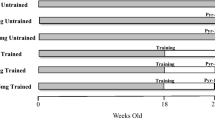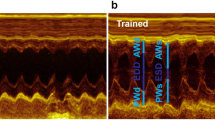Summary
An investigation was carried out on the effects of 4 weeks' swimming training (2×90 min/day) on myocardial isometric tension development and rate of tension rise, and also on the changes induced therein by in vitro application of isoproterenol. This was done in 9 isolated papillary muscles of 9-weekold male Wistar rats and the results were compared with the data of age-matched sedentary controls. Ventricular β-adrenoceptors ([3H]-dihydroalprenolol binding) and the isoenzyme pattern of myosin (pyrophosphate gel electrophoresis) were examined in the same individuals. Isometric tension (T) and its first derivative (dT/dt) measured at the optimum of the length-tension diagram were moderately increased by long-term swimming training. Isoproterenol (10−5 mol/l) induced a greater absolute and relative increase of both mechanical parameters in specimens of trained animals than in age-matched controls (†T: 3.6±1.6 vs. 1.9±0.6×10−2 N/mm2, p<0.05. †dT/dt: 43.4±14.0 vs. 30.4±9.5×10−2 N/mm2·s, p<0.05). K d decreased significantly (4.23±1.0 vs. 2.44±0.3 nM, p<0.02), indicating an increase in receptor affinity, whereas receptor density revealed a tendency to decrease (98.8±22.6 vs. 67.1±18.0 fmol/mg protein, p<0.1). In addition, there was a shift in the isoenzyme pattern of myosin towards VM-1 after swimming training.
Thus, under the conditions of the present experiments, the mechanical response to isoproterenol does not correlate to β-adrenoceptor density. It is probable that, apart from the altered sensitivity of the receptors, other membrane or post-membrane processes, are responsible for the increased mechanical responsiveness to catecholamines. Although a relationship between myosin isoenzyme pattern and mechanical responsiveness to catecholamines is apparent taking into account our results and the findings on hypertensive rats as reported in the literature, it cannot be accounted for simply by altered β-adrenoceptor density.
Similar content being viewed by others
References
Ayobe MH, Tarazi RC (1983) Beta-receptors and contractile reserve in left ventricular hypertrophy. Hypertension 5:(Suppl I) 192–197
Bersohn MM, Scheuer J (1977) Effects of physical training on end-diastolic volume and myocardial performance of isolated rat hearts. Circ Res 40:510–516
Bhan AK, Scheuer J (1972) Effects of physical training on cardiac actomyosin adenosine triphosphatase activity. Am J Physiol 223:1486–1490
Bradford MM (1976) A rapid and sensitive method of the quantitation of microgram quantities of protein utilizing the principle of protein-dye binding. Anal Biochem 72:248–254
Cerione RA, Strulovici B, Benovic JL, Lefkowitz RJ, Caron MG (1983) Pure β-adrenergic receptor: the single polypeptide confers catecholamine responsiveness to adenylate cyclase. Nature 306:562–566
Crews J, Aldinger EE (1967) Effect of chronic exercise on myocardial function. Am Heart J 74:536–542
Cutilletta AF, Edmiston K, Dowell RT (1979) Effect of a mild exercise program on myocardial function and the development of hypertrophy. J Appl Physiol 46:354–360
d'Albis A, Pantaloni C, Becher JJ (1979) An electrophoretic study of native myosin isoenzymes and of their subunit content. Eur J Biochem 99:261–272
Dohm GL, Pennington SN, Barakat H (1976) Effects of exercise training on adenyl cyclase and phosphodiesterase. Biomed Med 16:138–142
Fuller EO, Nutter DO (1981) Endurance training in the rat. II Performance of isolated and intact heart. J Appl Physiol 51:941–947
Goltz D (1974) Einfluß eines mehrwöchigen Schwimmtrainings auf das Mechanogramm des Rattenventrikelmyokards. Inaugural-Dissertation, Tübingen
Hepp A, Hansis M, Gülch R, Jacob R (1974) Left ventricular isovolumetric pressure-volume relations, “diastolic tone”, and contractility in the rat heart after physical training. Basic Res Cardiol 69:516–532
Hoh HFY, McGrath PA, Hale PT (1978) Electrophoretic analysis of multiple forms of rat cardiac myosin: Effects of hypophysectomy and thyroxine replacement. J Mol Cell Cardiol 10:1053–1076
Jacob R, Rupp H, Ebrecht G, Gülch RW, Kissling G (1981) Chronic reaction of myocardium at the myofibrillar level. In: Nagano M, Seki I (eds) Cardiac structure and metabolism; Vol 4, Roppo (Tokyo), 1–28
Jacob R, Kissling G, Ebrecht G, Holubarsch CH, Rupp H (1984) Das Sportherz im Tierversuch: Einfluß eines chronischen Schwimmtrainings auf Herzdynamik, Myokardfunktion und kontraktile Proteine bei der Ratte. In: Jeschke D (ed) Stellenwert der Sportmedizin in Medizin und Sportwissenschaften. Springer, Heidelberg New York, 34–47
Kämmereit A, Medugorac I, Steil E, Jacob R (1975) Mechanics of the isolated ventricular myocardium of rats conditioned by physical training. Basic Res Cardiol 70:495–507
Kopp SJ, Bárány M (1979) Phosphorylation of the 19,000-dalton light chain of myosin in perfused rat heart under the influence of negative and positive inotropic agents. J Biol Chem 254:12007–12012
Lehmann M, Rühle K, Schmid P, Klein H, Matthys K, Keul J (1983) Hämodynamik, Plasmakatecholaminverhalten und β-Adrenozeptorendichte bei Trainierten, Untrainierten und Herzinsuffizienten. Z Kardiol 72:529–536
Malhotra A, Penpargkul S, Schaible T, Scheuer J (1981) Contractile proteins and sarcoplasmic reticulum in physiologic cardiac hypertrophy. Am J Physiol 241:H263-H267
Medugorac I, Kämmereit A, Jacob R (1975) Einfluß eines chronischen Schwimmtrainings auf Struktur und Enzymaktivität von Myosin beim Rattenmyokard. Hoppe Seyler's Z Physiol Chem 356:1161–1171
Molé PA (1978) Increased contractile potential of papillary muscles from exercise-trained rat hearts. Am J Physiol 234:H421-H425
Moore RL, Riedy M, Gollnick PD (1982) Effect of training on β-adrenergic receptor number in rat heart. J Appl Physiol 52:1133–1137
Nutter DO, Priest RE, Fuller EO (1981) Endurance training in the rat. I. Myocardial mechanics and biochemistry. J Appl Physiol 51:934–940
Östman-Smith I (1979) Adaptive changes in the sympathetic nervous system and some effector organs of the rat following long term exercise or cold acclimation and the role of cardiac sympathethic nerves in the genesis of compensatory cardiac hypertrophy. Acta Physiol Scand Suppl 477:1–118
Penpargkul S, Scheuer J (1970) The effect of physical training upon the mechanical and metabolic performance of the rat heart. J Clin Invest 49:1859–1868
Penpargkul S, Repke DI, Katz AM, Scheuer J (1977) Effect of physical training on calcium transport by rat cardiac sarcoplasmic reticulum. Circ Res 40:134–138
Resink TJ, Gevers W, Noakes TD, Opie LH (1981) Increased cardiac myosin ATPase activity as a biochemical adaptation to running training: enhanced response to catecholamines and a role for myosin phosphorylation. J Mol Cell Cardiol 13:679–694
Ritzer TF, Bove AA, Carey RA (1980) Left ventricular performance characteristics in trained and sedentary dogs. J Appl Physiol 48:130–138
Rupp H (1981) The adaptive changes in the isoenzyme pattern of myosin from hypertrophied rat myocardium as a result of pressure overload and physical training. Basic Res Cardiol 76:79–88
Rupp H, Jacob R (1982) Response of blood pressure and cardiac myosin polymorphism to swimming training in the spontaneously hypertensive rat. Can J Physiol Pharmacol 60:1098–1103
Rupp H, Bukhari AR, Jacob R (1983) Regulation of cardiac myosin isoenzymes-the interrelationship with catecholamine metabolism. J Mol Cell Cardiol 15 (Suppl 1):317
Schaible TF, Scheuer J (1979) Effects of physical training by running or swimming on ventricular performance of rat hearts. J Appl Physiol 46:854–860
Scatchard G (1949) The attractions of proteins for small molecules and ions. Ann NY Acad Sci 51:660–672
Scheuer J, Bhan AK (1979) Cardiac contractile proteins. Adenosine triphosphatase activity and physiological function. Circ Res 45:1–12
Schneider JA, Sperelakis N (1975) Slow Ca2+ and Na+ responses induced by isoproterenol and methylxanthines in isolated perfused guinea-pig hearts exposed to elevated K+. J Mol Cell Cardiol 7:249–274
Sordahl LA, Asimakis GK, Dowell RT, Stone HL (1977) Functions of selected biochemical systems from the exercise-trained dog heart. J Appl Physiol 42:426–431
Steil E, Hansis M, Hepp A, Kissling G, Jacob R (1975) Cardiac hypertrophy due to physical exercise; an example of hypertrophy without decrease of contractility: Unreliability of conventional estimation of contractility by simple parameters. Rec Advanc on Cardiac Structures and Metabolism 5:491–496
Sylvestre-Gervais L, Nadeau A, Nguyen MH, Tancrède G, Rousseau-Migneron S (1982) Effects of physical training on β-adrenergic receptors in rat myocardial tissue. Cardiovasc Res 16:530–534
Sylvestre-Gervais L, Nadeau A, Tancrède G, Nguyen MH, Rousseau-Migneron S (1984) Decrease in ventricular beta-adrenergic receptors in trained diabetic rats. Basic Res Cardiol 79:432–439
Tibbits G, Koziol BJ, Roberts NK, Baldwin KM, Barnard RJ (1978) Adaptation of the rat myocardium to endurance training. J Appl Physiol 44:85–89
Tibbits GF, Barnard RJ, Baldwin KM, Cugalj N, Roberts NK (1981) Influence of exercise on excitation-contraction coupling in rat myocardium. Am J Physiol 240:H472-H480
Williams RS, Lefkowitz RJ (1978) Alpha-adrenergic receptors in rat myocardium. Identification by binding of [3H]dihydroergocryptine. Circ Res 43:721–727
Williams RS (1980) Physical conditioning and membrane receptors for cardioregulatory hormones. Cardiovasc Res 14:177–182
Winegrad S, McClellan G, Tucker M, Lin LE (1983) Cyclic AMP regulation of myosin isozymes in mammalian cardiac muscle. J Gen Physiol 81:749–765
Wyatt HL, Chuck L, Rabinowitz B, Tyberg JV, Parmley WW (1978) Enhanced cardiac response to catecholamines in physically trained cats. Am J Physiol 234:H608-H613
Author information
Authors and Affiliations
Rights and permissions
About this article
Cite this article
Takeda, N., Dominiak, P., Türck, D. et al. The influence of endurance training on mechanical catecholamine responsiveness, β-adrenoceptor density and myosin isoenzyme pattern of rat ventricular myocardium. Basic Res Cardiol 80, 88–99 (1985). https://doi.org/10.1007/BF01906747
Received:
Issue Date:
DOI: https://doi.org/10.1007/BF01906747




